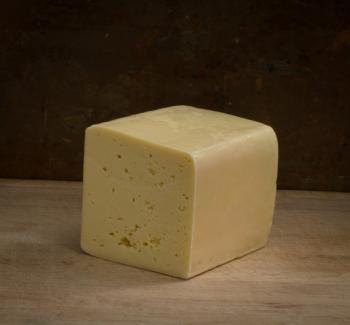Havarti (Danish)
- Producer
- Denmark's Tradition
- Country
- Denmark
- Region
- Vejle
- Size
- 12 ins long, 4 ins diameter
- Weight
- 12 lbs
- Website
- Milk
- Cow
- Classification
- Semi Soft
- Rennet
- Animal
- Rind
- Waxed

Although Havarti has become somewhat ubiquitous today, much of it taking the form of mildly flavored Cream Havarti produed on a large scale, traditional Havarti was originally made in small quantities, often on the farm or small dairy, and had a fuller, deeper flavor. The traditional version originated in Denmark in the mid 1800’s, when Hanne Nielsen, a farmer, decided to travel around Europe in order to learn the art of cheesemaking. Once back at her own farm at Havarthigaard, north of Copenhagen, she produced a cheese that she named after the farm, giving rise to Havarti. The version featured here is stylistically close to Nielsen’s cheese and is made by a second generation cheesemaker at a dairy in Syddanmark that was founded in 1909. Having been a cooperative for many years, the business was running into trouble when it was bought out by the current family owners in 1959. Private enterprise is extremely unusual in Denmark with approximately 95% of cheese production taking place within a cooperative environment. This traditionally produced, smear-ripened Havarti is produced using four cheese vats. After the milk has coagulated, the curd is pumped out of the vats onto draining tables, where the whey is left to drain out naturally without pressing. Once drained, the curd is put into loaf-shaped molds and flipped several times over the course of 24 hours in a warm environment to expel more whey. Cheeses are unmolded and placed in a brine solution for 48 hours before being allowed to mature for between five and eight weeks. During the aging process, cheeses are smear-ripened by being dipped into a mixture of potato starch, water and bacterial cultures. Before dipping, cheeses are white in color and fourteen days later having been dipped at regular intervals, they are bright orange. Before being released for sale, cheeses are scraped to remove the smear-ripened crust that forms and a delicate coating of wax applied to the exterior.
Tasting Notes
The texture of this Havarti is semi-firm and the paste is dotted with small “eyes” or holes that tend to distribute themselves horizontally throughout the cheese.
Flavors are buttery and nutty, accompanied by a pleasant underlying funk – a result of the smear-ripening process.



